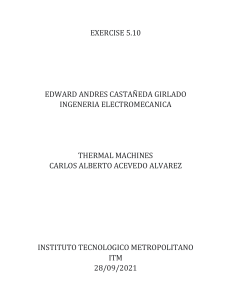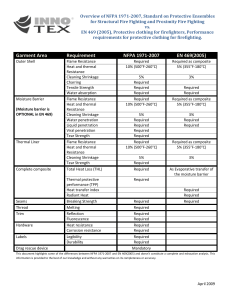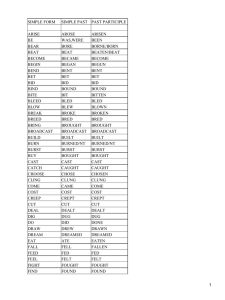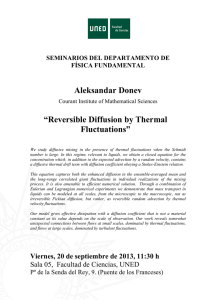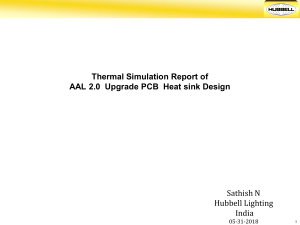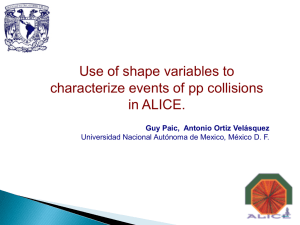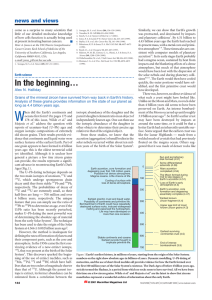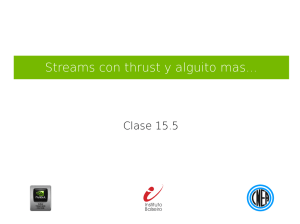One- and two-dimensional models are equally effective in
Anuncio
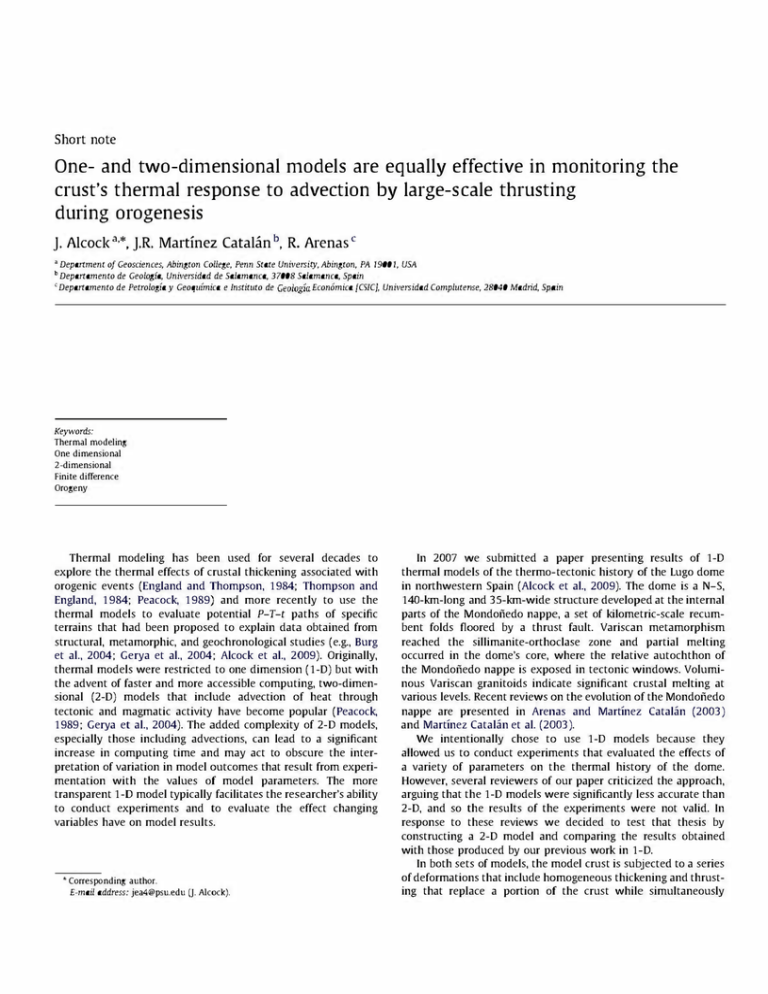
Short note
One- and two-dimensional models are equally effective in monitoring the
crust's thermal response to advection by large-scale thrusting
during orogenesis
J. Alcocka.*, J.R. Martinez Cataian b, R. Arenas C
a
Department of Geosciences, Abington College, Penn State University, Abington, PA 19001, USA
C
Departamento de Petrologia y Geoqulmica e Instituto de Ge%gia Economica {CSIC}, Universidad Complutense, 28040 Madrid, Spain
b Departamento
de Geoiogia, Universidad de Salamanca, 37008 Salamanca, Spain
Keywords:
Thermal modeling
One dimensional
2-dimensional
Finite difference
Orogeny
Thermal modeling has been used for several decades to
In 2007 we submitted a paper presenting results of 1-0
explore the thermal effects of crustal thickening associated with
thermal models of the thermo-tectonic history of the Lugo dome
orogenic events (England and Thompson, 1984; Thompson and
in northwestern Spain (Alcock et al., 2009). The dome is a N-S,
England, 1984; Peacock, 1989) and more recently to use the
thermal models to evaluate potential P-T-t paths of specific
140-km-long and 35-km-wide structure developed at the internal
parts of the Mondofiedo nappe, a set of kilometric-scale recum­
terrains that had been proposed to explain data obtained from
bent folds floored by a thrust fault. Variscan metamorphism
structural, metamorphic, and geochronological studies (e.g., Burg
reached the
et aI., 2004; Gerya et aI., 2004; Alcock et aI., 2009). Originally,
occurred in the dome's core, where the relative autochthon of
sillimanite-orthoclase
zone
and partial melting
thermal models were restricted to one dimension (1-0) but with
the Mondofiedo nappe is exposed in tectonic windows. Volumi­
the advent of faster and more accessible computing, two-dimen­
nous Variscan granitoids indicate significant crustal melting at
sional (2-0) models that include advection of heat through
various levels. Recent reviews on the evolution of the Mondofiedo
tectonic and magmatic activity have become popular (Peacock,
nappe are presented in Arenas and Martinez Catalan (2003)
1989; Gerya et aI., 2004). The added complexity of 2-D models,
and Martinez Catalan et al. (2003).
especially those including advections, can lead to a significant
We intentionally chose to use 1-0 models because they
increase in computing time and may act to obscure the inter­
allowed us to conduct experiments that evaluated the effects of
pretation of variation in model outcomes that result from experi­
a variety of parameters on the thermal history of the dome.
mentation with the values of model parameters. The more
However, several reviewers of our paper criticized the approach,
transparent 1-0 model typically facilitates the researcher's ability
arguing that the 1-0 models were significantly less accurate than
to conduct experiments and to evaluate the effect changing
2-0, and so the results of the experiments were not valid. In
variables have on model results.
response to these reviews we decided to test that thesis by
constructing a 2-0 model and comparing the results obtained
with those produced by our previous work in 1-0.
In both sets of models, the model crust is subjected to a series
.. Corresponding author.
E-mail address: [email protected] 0. Alcock).
of deformations that include homogeneous thickening and thrust­
ing that replace a portion of the crust while simultaneously
A
A
0
800
10
20
<r
30
-1-0 Model
_
_
2-0 Model
600
i':'
"
40
Tii
"
50
Cl.
0
20
40
60
80
400
E
100
"
f-
B
0
200
10
E
�
20
t
30
0
10
30
20
40
Oepth (km)
B
40
originating at depth of
30 Km after thrusting
50
0
20
40
60
80
1.0.-------r---,..-",
-- 1-0 Model
100
2-0 Model
_
0.8
C
2
0
10
0.6
10 Ma
20
20
30
0.4
40
50
0
20
40
60
Distance (Km)
80
0.2
100
'-_-'-"---'-_---'-_----'_--'-"---'---'
200
Fig. 1. Results from 2-D model after initial homogeneous thickening and at the
beginning of thrusting (A). at 4 Ma (B). and at 14 Ma (C) after a 6 Ma period of
thrusting ends are presented as crusta! cross-sections with isotherms. Source of
allochthon experienced 10 km of erosion prior to thrusting,which is the cause of
the temperature difference at distance 10 km in (A). Trace of the thrust surface in
the model is shown with a dashed line. The effect of the thrust on the location of a
rock at a depth of 3 0 km before thrusting is shown with a heavy solid line.
thickening the crust to model the emplacement of the Mondo­
fiedo nappe. Thickening is followed by thermal relaxation and
300
400
500
Results
from
the
two
methods
are
illustrated
C
C1
models are accomplished by using a natural strain parameter to
calculate incremental vertical movement of model nodes. A listing
of representative parameters used in the experiment is presented
in Table 1.
The treatment of thrusting is the most important difference
between the 1-0 and the 2-D models because instantaneous
emplacement is used in 1-0 while emplacement by incremental
movement is used in the 2-D model. In 2-D the thrust is treated as
moving along a ramp sloped at 14" and then along a flat where
the 20-km-thick thrust sheet replaces 10 km of autochthon. The
slope is arbitrary as it was chosen to allow incremental motion by
moving four nodes horizontally for each node of vertical move­
ment, but the relatively shallow dip of the ramp is reasonable. A
horizontal velocity of 1 cm per year of the thrust is achieved in
the model as a 4-km-long step resulting in 1 km or one node of
vertical
displacement
each
0.4 Ma.
Thrusting
continues
6.0 Ma, leading to a total horizontal displacement of 60 km.
for
800
1-0 Model
2-0 Model
30 6.931 x 10- 5
5
6.931 x 10- 0
per 1000 yr
per 1000 yr
10
60 time-step
time-step
0
10
C225
in
Figs. 1 and 2. Homogeneous thickening and thinning in both
700
Temperature ('C)
60 20 km replace 20
10 km
26
then by homogeneous thinning that returns the Moho to a depth
:::;: 40 km.
600
40
E1
60
40
2.798 x 10-5
per 1000 yr
time-step
------
20 km replace
70 10 km
40
70
60
40
2.798 x 10- 5
per 1000 yr
time-step
Depth to Moho
Fig. 2. A comparison of 1-D and 2-D models of the thermal histOlY of the Lugo
dome that includes homogeneous thickening followed by thrusting and eventual
homogeneous thinning. (A) Results are presented as crustal geotherms. Sawtooth
geotherm produced by instantaneous thickening has been smoothed and both
geotherms are similar within 15 Ma of thrusting. (B) Models are compared by
tracing the history of a particular node that originates at a depth of 10 km and
resides 10 km beneath the thrust after homogeneous thickening and thrusting.
The thermal histOlY of this node is essentially independent of the model used.
(e) A comparison of the two models showing stages of thickening and thinning of
the crust in response to compression and erosion.
Results of the 1-0 and 2-D models are compared in Fig. 2A
and B. As can be seen the P-T-t paths are nearly indistinguish­
able with the exception of the unrealistic instantaneous change
Table 1
Representative parameters used in thermal models.
Thermal conductivity
Thermal diffusivity
Radiogenic heat production,upper crust
Radiogenic heat flux at surface
Heat flux from asthenosphere
Surface temperature
Density
Initial crustal thickness
Initial thickness of radiogenic crust
Initial thickness of lithosphere
Initial homogeneous thickening factor
Distance between nodes
Time step
Natural elongation during thickening
Natural elongation during thinning
Velocity of thrust
Incline of thrust ramp
2.25 W m 1 K 1 (crust), 3. 3 W m 1 K 1 (mantle)
8. 3 3 x 10 7m2 s 1 (upper crust),7.76 x 10 7m2 s 1 (lower crust),1. 0x 10 6 m2 s
2.67 mW m 3
4 0 mW m 2 (autochthon), 25 mW m 2 (allochthonous complexes)
3 0mW m 2
25 "C
27 00 kg m 3 (upper crust), 2900 kg m 3 (lower crust), 326 0 k g m 3 (mantle)
3 0km
15 km
86 km (depth where T> 1300"C)
2. 0
l000m
1000 a
Exp(6. 9 3 1e-05) (crust doubled in 10 Ma)
Exp(-2.7 98e-05) (70 km of crust thinned to 4 0 km in 20 Ma)
1. 0cm a 1
14'
in pressure that models thrust emplacement in 1-0. We find the
1
(mantle)
References
similarity of model results to be impressive and conclude that
the results of the 1-0 model are as accurate as those obtained
using 2-0 methods and do not think that one could distinguish
between the two if one were attempting to compare the results
to an actual rock record. We recognize that multidimensional
models are useful when horizontal temperature gradients are
similar to vertical gradients. However, when considering advec­
tive heating by thrusting, the horizontal heat transfer will be
small relative to the vertical flux and so does not need to be
considered in the model. We feel that there are significant
advantages to 1-0 models derived from their relative simplicity
and that 1-0 models should not be dismissed as ineffective
simply because we have the ability to create more complex
representations of the geologic system.
Acknowledgments
We thank the reviewers T. Gerya and j.C Mareschal, for their
thoughtful comments on an earlier version of this paper. Research
presented was supported by Spanish projects CG12004-0463C02jBTE and CG12007-65338-C02jBTE (Ministerio de Educaci6n
y Ciencia, Oirecci6n General de Investigaci6n).
Alcock,J.E.,Martinez Catai.ln,J.R,Arenas,R,Diez Montes,A, 2009. Use of thermal
modeling to assess the tectono-metamorphic history of the Lugo and Sanabria
Domes, Northwest Iberia. Bulletin de la Societe Geologique de France 180,
85-103.
Arenas, R, Martinez Catalan, J.R, 2003. Low-P metamorphism following a
Barrovian-type evolution. Complex tectonic controls for a common transition,
as deduced in the Mondonedo thrust sheet (NW Iberian Massif). Tectonophy­
sics 365, 143-16 4.
Burg, J.-P., Kaus, B.j.P., Podladchikov, Y.Y., 2004. Dome structures in collision
orogens: mechanical investigation of the gravity/compression interplay. In:
Whitney, D.L., Teyssier, C, Siddoway, CS. (Eds.),Gneiss Domes in Orogeny,
Geological Society of America Special Paper,vo!. 380, pp. 47-66.
England, P.C, Thompson,AB., 1984. Pressure-temperature-time paths of regional
metamorphism I. Heat transfer during the evolution of regions of thickened
continental crust. Journal of Petrology 25, 894- 928.
Gerya, T.V.,Perchuk, LL,Maresch,W.v.,Willner,A.P.,2004. Inherent gravitational
instability of hot continental crust: implications for doming and diapirism in
granulite fades terrains. In: Whitney, D.L, Teyssier, C, Siddoway, CS. (Eds.),
Gneiss Domes in Orogeny, Geological Society of America Special Paper, vo!.
380,pp. 97-115.
Martinez Catalan, J.R, Arenas, R, Diez Balda, MA, 2003. Large extensional
structures developed during emplacement of a crystalline thrust sheet: the
Mondonedo nappe (NW Spain). Journal of Structural Geology 25,1815-1839.
Peacock, S.M., 1989. Thermal modeling of metamorphic-pressure-temperature­
time paths. In: Spear, F.S., Peacock, S.M. (Eds.), Metamorphic Pressure­
Temperature-Time Paths, American Geophysical Union, Short Course in
Geology, vo!. 7,pp. 57-102.
Thompson,AB.,England,P.C,1984. Pressure-temperature-time paths of regional
metamorphism. n. Their inference and interpretation using mineral assem­
blages in metamorphic rocks. Journal of Petrology 25, 929- 955.
